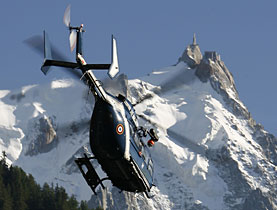Double avalanche claims several lives

At least four people died and five were injured in avalanches on Sunday in the Bernese Alps – one of the worst accidents of its kind in recent years.
The police said at least three other people were missing and believed to be buried under the snow from avalanches that killed two ski mountaineers and a doctor involved in the search and rescue operation.
It was the first time in the history of the Swiss Air Rescue Service (Rega) that a team member died trying to free people from an avalanche.
The cantonal police in Bern said the first avalanche came down a mountainside in the Diemtig Valley shortly before midday, burying one of the skiers. Shortly after a rescue team arrived on the scene a second avalanche thundered down the slope, trapping several people involved in the search for the trapped skier.
Dozens of other rescuers and dogs flown in by Rega managed to dig eight people out of the snow, and recovered one body. Three – including the doctor – died later in hospital from their injuries.
The search for other people who may have been trapped by the snow mass was called off at 6pm.
At a media conference on Monday evening, police said poor weather had prevented the search from resuming on Monday. It was set to continue on Tuesday.
The three dead were identified as two Swiss and one German – the same as the three missing – and the five injured comprised one Canadian, one Swiss and three Germans.
Bern cantonal police spokesman Otto von Almen said a fourth person who was pulled from the snow alive, but later died in the hospital, hadn’t been formally identified.
Skiers not “irresponsible”
The avalanche risk in the area was moderate when the accident took place, according to the Swiss Institute for Snow and Avalanche Research (SLF).
Avalanche forecaster at the SLF, Christine Pielmeier, told swissinfo.ch that the danger level for all of the Bernese Alps had been raised on Monday to “considerable” because of the weekend avalanches and further snowfall expected.
Pielmeier said it was still unclear what set off the avalanches.
A mountain accident expert at the Swiss Alpine Club, Ueli Mosimann, said that it was not “irresponsible” for skiers to have climbed and skied down the Drümännler peak in Sunday’s conditions.
However, Mosimann told swissinfo.ch that the very warm weather in the region last week followed by a cold front may have meant the 20cm of fresh snow that fell at the weekend did not have a chance to bind with the lower layer, and was therefore unstable.
Both Mosimann and Pielmeier said it was rare that a second – in this case more deadly – avalanche occurred.
Better equipped
In a separate incident on Sunday, a ski mountaineer died in an avalanche near the Swiss ski resort of Verbier. A rescue team was able to free the mountain guide accompanying him.
The deaths come only a week after the SLF released the findings of a study which said better gear and improved awareness have led to a drastic reduction in the number of people killed each year by avalanches.
According to the institute, around 40 per cent of people caught in avalanches die. At the end of the 1970s, the figure was around 60 per cent.
The authors of the study said off-piste skiers, snowboarders and snowshoers are better equipped nowadays, are more likely to inform themselves about local snow conditions and know how to react to free colleagues trapped in an avalanche.
Between 1977 and 2006 nearly 3,500 people were caught in slides in the Swiss Alps. More than 700 died. While 27 people on average were killed each winter over the first 15 years, only 20 died per year in the second half of this period.
The decrease is also remarkable since, the SLF said, tourists are more likely today to leave marked ski slopes and hiking trails.
The SLF recommends that people going off piste be equipped with emergency gear such as shovels and transceivers. Equally important is knowing how to use them, it said.
swissinfo.ch and agencies
1 low – avalanche possible only with high additional loads (e.g. groups of skiers without spacing, snowmobile), on very few extreme slopes. Only natural sluffs (small loose snow avalanches) and small avalanches possible.
2 moderate – triggering possible especially through high additional loads, mainly on steep slopes indicated in bulletin. Large natural avalanches not expected.
3 considerable – triggering possible even through low additional loads, mainly on steep slopes… In certain conditions, some medium and occasionally large natural avalanches possible.
4 high – triggering is probable even through low additional loads on many steep slopes. In certain conditions, many medium and multiple large natural avalanches are expected.
5 very high – many large natural avalanches are expected even in moderately steep terrain.
(Source: Swiss Federal Institute for Snow and Avalanche Research)

In compliance with the JTI standards
More: SWI swissinfo.ch certified by the Journalism Trust Initiative













You can find an overview of ongoing debates with our journalists here . Please join us!
If you want to start a conversation about a topic raised in this article or want to report factual errors, email us at english@swissinfo.ch.